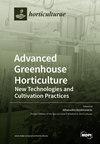利用甜樱桃树树冠的时空温度数据模型分析果实表面的潮湿情况
IF 3.1
3区 农林科学
Q1 HORTICULTURE
引用次数: 0
摘要
通常情况下,甜樱桃的果实开裂与直接(雨和雾)和间接(冷暴露和露水)机制导致的果实表面游离水有关。近距离遥感技术的最新进展使得基于光探测与测距(LiDAR)和热成像技术的高空间分辨率温度分布监测成为可能。将 LiDAR 衍生的几何三维点云与合并的热数据融合,可提供空间分辨率较高的果实温度数据,如同 LiDAR 四维点云。本文旨在利用这种新方法研究甜樱桃树冠的热行为,重点是露点附近的果实表面温度。甜樱桃树被储存在冷室(6 °C)中,随后在室温下以不同的时间间隔进行扫描。共识别出 62 个甜樱桃 LiDAR 4D 点云。通过人工参考读数(n = 40)对估计的温度分布进行了验证,发现理想情况和实际情况下的平均 R2 值分别为 0.70 和 0.94。树冠密度是通过与树冠相关的果实激光雷达点的数量比来估算的。甜樱桃表面的湿度是通过目测评估的,并与估计的露点(Ydew)指数进行比较。当平均露点指数为 1.17 时,果实表面未出现潮湿现象。树冠密度比对热动力学和细长纺锤形结构甜樱桃表面湿度的影响微乎其微。根据估计的果实温度分布建立果实表面湿度模型,有助于对考虑抵御气候变化的树木结构进行生态生理学研究,也有助于对果实生理失调进行研究。本文章由计算机程序翻译,如有差异,请以英文原文为准。
Occurrence of Wetness on the Fruit Surface Modeled Using Spatio-Temporal Temperature Data from Sweet Cherry Tree Canopies
Typically, fruit cracking in sweet cherry is associated with the occurrence of free water at the fruit surface level due to direct (rain and fog) and indirect (cold exposure and dew) mechanisms. Recent advances in close range remote sensing have enabled the monitoring of the temperature distribution with high spatial resolution based on light detection and ranging (LiDAR) and thermal imaging. The fusion of LiDAR-derived geometric 3D point clouds and merged thermal data provides spatially resolved temperature data at the fruit level as LiDAR 4D point clouds. This paper aimed to investigate the thermal behavior of sweet cherry canopies using this new method with emphasis on the surface temperature of fruit around the dew point. Sweet cherry trees were stored in a cold chamber (6 °C) and subsequently scanned at different time intervals at room temperature. A total of 62 sweet cherry LiDAR 4D point clouds were identified. The estimated temperature distribution was validated by means of manual reference readings (n = 40), where average R2 values of 0.70 and 0.94 were found for ideal and real scenarios, respectively. The canopy density was estimated using the ratio of the number of LiDAR points of fruit related to the canopy. The occurrence of wetness on the surface of sweet cherry was visually assessed and compared to an estimated dew point (Ydew) index. At mean Ydew of 1.17, no wetness was observed on the fruit surface. The canopy density ratio had a marginal impact on the thermal kinetics and the occurrence of wetness on the surface of sweet cherry in the slender spindle tree architecture. The modelling of fruit surface wetness based on estimated fruit temperature distribution can support ecophysiological studies on tree architectures considering resilience against climate change and in studies on physiological disorders of fruit.
求助全文
通过发布文献求助,成功后即可免费获取论文全文。
去求助

 求助内容:
求助内容: 应助结果提醒方式:
应助结果提醒方式:


